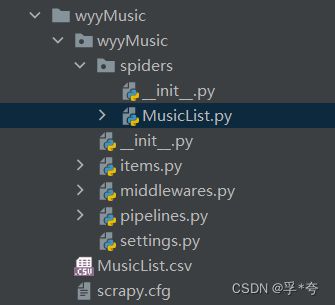Python Scrapy 多线程爬取网易云音乐热门歌单信息(手把手教学)
下面我将向大家介绍使用 Scrapy 爬虫获取 网易云音乐 的热门歌单信息。
这里是网易云音乐的歌单页面,可以看到歌单信息非常得结构化,是非常适合爬虫来爬取的。
URL:全部歌单 - 歌单 - 网易云音乐 (163.com)
爬取结果预览(爬取时间提早于写这篇文章时间约一周,所以歌单信息部分有变化):
一、首先来看一下Scrapy的组成:
![]()
Scrapy框架主要由五大组件组成,它们分别是调度器(Scheduler)、下载器(Downloader)、爬虫(Spider)和实体管道(Item Pipeline)、Scrapy引擎(Scrapy Engine)。下面我们分别介绍各个组件的作用。
(1)、调度器(Scheduler):
调度器,说白了把它假设成为一个URL(抓取网页的网址或者说是链接)的优先队列,由它来决定下一个要抓取的网址是 什么,同时去除重复的网址(不做无用功)。用户可以自己的需求定制调度器。
(2)、下载器(Downloader):
下载器,是所有组件中负担最大的,它用于高速地下载网络上的资源。Scrapy的下载器代码不会太复杂,但效率高,主要的原因是Scrapy下载器是建立在twisted这个高效的异步模型上的(其实整个框架都在建立在这个模型上的)。
(3)、 爬虫(Spider):
爬虫,是用户最关心的部份。用户定制自己的爬虫(通过定制正则表达式等语法),用于从特定的网页中提取自己需要的信息,即所谓的实体(Item)。 用户也可以从中提取出链接,让Scrapy继续抓取下一个页面。
(4)、 实体管道(Item Pipeline):
实体管道,用于处理爬虫(spider)提取的实体。主要的功能是持久化实体、验证实体的有效性、清除不需要的信息。
(5)、Scrapy引擎(Scrapy Engine):
Scrapy引擎是整个框架的核心.它用来控制调试器、下载器、爬虫。实际上,引擎相当于计算机的CPU,它控制着整个流程。
重点:一个Scrapy项目的文件目录结构如下:
我们需要编辑的一般只有 spiders 、items.py、 pipeline.py、settings.py
在桌面新建一个项目文件夹,然后使用pycharm打开,在终端(Terminal)中输入:
scrapy startproject 爬虫项目名称 #创建一个Scrapy爬虫项目
cd my 爬虫项目名称 #进入到此项目中
如本文是:
scrapy startproject wyyMusic
cd wyyMusic
这样一个网易云音乐爬虫项目就创建好了。
二、编写具体爬虫代码
1. 设置settings.py
在settings.py中写上一下代码:(用于设置爬虫的一些全局配置信息)
#去除掉日志中其他描述性的信息,只输出我们需要的信息
LOG_LEVEL = "WARNING"
USER_AGENT = '自己浏览器的user agent'
#默认为True,更改为False,即不遵守君子协定
ROBOTSTXT_OBEY = False
#下载延迟,可以设为每下载一次暂停2秒,以防下载过快被禁止访问
DOWNLOAD_DELAY = 2
DEFAULT_REQUEST_HEADERS = {
'Accept': 'text/html,application/xhtml+xml,application/xml;q=0.9,*/*;q=0.8',
# 'Accept-Language': 'en', #不要这条代码
}
2. 设置items.py:(定义需要爬取的字段)
import scrapy
class MusicListItem(scrapy.Item):
SongsListID = scrapy.Field() #歌单id号
SongListName = scrapy.Field() #歌单名
AmountOfPlay = scrapy.Field() #播放量
Labels = scrapy.Field() #标签名
Url = scrapy.Field() #歌单域名,为下一次详细爬取留备份
Collection = scrapy.Field() #歌单收藏量
Forwarding = scrapy.Field() #转发量
Comment = scrapy.Field() #评论量
NumberOfSongs = scrapy.Field() #歌曲数量
CreationDate = scrapy.Field() #歌单创建日期
AuthorID = scrapy.Field() #作者id3. 创建歌单爬虫 MusicList.py:
在spiders包下新建一个 MusicList.py,创建后的目录结构如下
在MusicList.py中获取歌单信息
import scrapy #导入scrapy 包
#使用相对路径从我们刚刚编写的items.py中导入MusicListItem类
from ..items import MusicListItem
#导入深拷贝包,用于在爬取多个页面时保存到pipeline中的歌单信息顺序不会乱,防止出现重复,非常关键
from copy import deepcopy
class MusicListSpider(scrapy.Spider):
name = "MusicList" #必须要写name属性,在pipeline.py中会用到
allowed_domains = ["music.163.com"] #设置爬虫爬取范围
start_urls = ["https://music.163.com/discover/playlist"] #起始爬取的页面,即歌单第一面
offset = 0 #自己设置的一个指针,用于记录当前爬取的页码
def parse(self, response):
#使用.xpath语法来从HTML页面中解析需要的信息
#获取一页中的全部歌单,保存到liList中
liList = response.xpath("//div[@id='m-disc-pl-c']/div/ul[@id='m-pl-container']/li")
#对liList中的歌单,一个一个遍历,获取歌单详细页面的信息
for li in liList:
itemML = MusicListItem()
a_href = li.xpath("./div/a[@class = 'msk']/@href").extract_first()
itemML["SongsListID"]= a_href[13:]
#获取歌单详细页面的Url地址
Url = "https://music.163.com" + a_href
itemML["Url"] = Url
#调用SongsListPageParse来获取歌单详细页面的信息
yield scrapy.Request(Url, callback=self.SongsListPageParse, meta={"itemML" : deepcopy(itemML)})
#爬取下一页
if self.offset < 37:
self.offset += 1
#获取下一页的Url地址
nextpage_a_url="https://music.163.com/discover/playlist/?order=hot&cat=%E5%85%A8%E9%83%A8&limit=35&offset=" + str(self.offset*35)
print(self.offset ,nextpage_a_url)
yield scrapy.Request(nextpage_a_url, callback=self.parse)
print("开始爬下一页")
#用于爬取每一个歌单中的详细页面信息
def SongsListPageParse(self, response):
cntc = response.xpath("//div[@class='cntc']")
itemML = response.meta["itemML"]
SongListName = cntc.xpath("./div[@class='hd f-cb']/div/h2//text()").extract_first()
itemML["SongListName"] = SongListName #获取歌单名
user_url = cntc.xpath("./div[@class='user f-cb']/span[@class='name']/a/@href").extract_first()
user_id = user_url[14:]
itemML["AuthorID"] = user_id #获取歌单创作者id号
time = cntc.xpath("./div[@class='user f-cb']/span[@class='time s-fc4']/text()").extract_first()
itemML["CreationDate"] = time[0:10] #获取歌单创建日期
aList = cntc.xpath("./div[@id='content-operation']/a")
Collection = aList[2].xpath("./@data-count").extract_first()
itemML["Collection"] = Collection #获取收藏量
Forwarding = aList[3].xpath("./@data-count").extract_first()
itemML["Forwarding"] = Forwarding #获取转发量
Comment = aList[5].xpath("./i/span[@id='cnt_comment_count']/text()").extract_first()
itemML["Comment"] = Comment #获取评论量
tags = ""
tagList = cntc.xpath("./div[@class='tags f-cb']/a")
for a in tagList:
tags = tags + a.xpath("./i/text()").extract_first() + " "
itemML["Labels"] = tags
songtbList = response.xpath("//div[@class='n-songtb']/div")
NumberOfSongs = songtbList[0].xpath("./span[@class='sub s-fc3']/span[@id='playlist-track-count']/text()").extract_first()
itemML["NumberOfSongs"] = NumberOfSongs
AmountOfPlay = songtbList[0].xpath("./div[@class='more s-fc3']/strong[@id='play-count']/text()").extract_first()
itemML["AmountOfPlay"] = AmountOfPlay
yield itemML #将爬取的信息传给 pipelines.py
每一页的每一个歌单,都对应一个 li 标签,li标签中的a标签就是歌单详细页面的地址
进入到一个歌单的详细信息页面:
我们爬取的信息就是上图中画红框的地方,它们对应的字段名为:
SongsListID = scrapy.Field() #歌单id号 SongListName = scrapy.Field() #歌单名 AmountOfPlay = scrapy.Field() #播放量 Labels = scrapy.Field() #标签名 Url = scrapy.Field() #歌单域名,为下一次详细爬取留备份 Collection = scrapy.Field() #歌单收藏量 Forwarding = scrapy.Field() #转发量 Comment = scrapy.Field() #评论量 NumberOfSongs = scrapy.Field() #歌曲数量 CreationDate = scrapy.Field() #歌单创建日期 AuthorID = scrapy.Field() #作者id
它们都是在 SongsListPageParse 函数中,通过解析歌单详细信息页面的来获取。
爬取下一页:
获取下一页的方法有两种:
一是从 每页的“下一页” a标签中获取下一页的url地址
二是根据翻页的规律,每页的url中的offset参数相差35(即每页有35个歌单),因此只要令 offset+= 35 进行循环就可以一直爬取到下一页,直到 offset <= 35 * 37 为止,37是有37页。
其实每次 ,所以在爬取下一页的时候没有用for ,而只是用 if 来判断offset
yield scrapy.Request(nextpage_a_url, callback=self.parse)
其实就是一个递归,调用parse函数自身。
由于第二种方法更为简便,所以这里使用的第二种方法来爬取下一页
4. 设置pipelines.py 来保存获取到的信息(即item)
from scrapy.exporters import CsvItemExporter
class WyymusicPipeline:
def __init__(self):
self.MusicListFile = open("MusicList.csv", "wb+") #保存为csv格式
self.MusicListExporter = CsvItemExporter(self.MusicListFile, encoding='utf8')
self.MusicListExporter.start_exporting()
def process_item(self, item, spider):
if spider.name == 'MusicList':
self.MusicListExporter.export_item(item)
return item5.终于到了激动人心的时刻!—— 启动爬虫
在终端(Terminal)中输入:
scrapy crawl MusicList
(注意:在此之前要保证是在wyyMusic爬虫目录下,若不在,则可以通过 cd wyyMusic 来进入到爬虫目录下。)
已经在开始爬取了!过一会儿会自动在wyyMusic 包下生成MusicList.csv 文件,里面存放的就是爬取到的并整理好的全部热门歌单信息。
最终爬取到了1288个歌单,效果如下:
最后:
网易云音乐中有些页面的信息无法使用Scrapy来爬取,表现为爬取到的内容为空。这时候就需要使用python Selenium爬虫来爬取,下篇文章将教小伙伴们使用Selenium爬虫来爬取网易云音乐用户页面详细信息,如用户昵称、性别、vip等级、所在地、简介、收藏与创建的歌单歌曲、粉丝等等信息。











